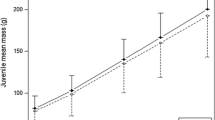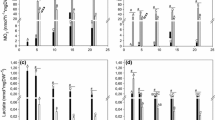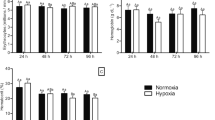Abstract
Since European sea bass (Dicentrarchus labrax) larvae occurred in coastal and estuarine waters at early life stages, they are likely to be exposed to reduced dissolved oxygen waters at a sensitive developmental stage. However, the effects of hypoxia at larval stage, which depend in part on fish species, remain very poorly documented in European sea bass. In the present study, the impacts of an experimental exposure to a chronic moderate hypoxia (40 % air saturation) between 30 and 38 days post-hatching on the physiological and developmental traits of European sea bass larvae were assessed. This study was based on the investigation of survival and growth rates, parameters related to energy metabolism [Citrate Synthase (CS) and Cytochrome-c Oxidase (COX) activities], and biological indicators of the maturation of digestive function [pancreatic (trypsin, amylase) and intestinal (Alkaline Phosphatase “AP” and Aminopeptidase-N “N-LAP”) enzymes activities]. While condition of hypoxia exposure did not induce any significant mortality event, lower growth rate as well as CS/COX activity ratio was observed in the Hypoxia Treatment group. In parallel, intestinal enzyme activities were also lower under hypoxia. Altogether, the present data suggest that sea bass larvae cope with moderate hypoxia by (1) reducing processes that are costly in energy and (2) regulating mitochondria functions in order to respond to energy-demand conditions. Both these effects are associated with a delay in the maturation of the digestive function.




Similar content being viewed by others
Abbreviations
- AP:
-
Alkaline Phosphatase
- C:
-
Control group
- COX:
-
Cytochrome-c Oxidase
- CS:
-
Citrate Synthase
- d.p.h.:
-
Days post-hatching
- FI:
-
Feed intake
- H:
-
Head
- HT:
-
Hypoxia treatment
- IS:
-
Intestinal segment
- N-LAP:
-
Aminopeptidase-N
- NS:
-
No significant differences
- PS:
-
Pancreatic segment
- RMR:
-
Routine metabolic rate
- s.e.m.:
-
Standard error of mean
- T:
-
Tail
References
Almeida-Val VMF, Oliveira AR, da Silva MDP, Ferreira-Nozawa MS, Araujo RM, Val AL, Nozawa SR (2011) Anoxia- and hypoxia-induced expression of LDH-A* in the Amazon Oscar, Astronotus crassipinis. Genet Mol Biol 34:315–322
Anjos MB, De Oliveira RR, Zuanon J (2008) Hypoxic environments as refuge against predatory fish in the Amazonian floodplains. Braz J Biol 68:45–50
Barrionuevo WR, Fernandes MN, Rocha O (2010) Aerobic and anaerobic metabolism for the zebrafish, Danio rerio, reared under normoxic and hypoxic conditions and exposed to acute hypoxia during development. Braz J Biol 70:425–434
Bickler PE, Buck LT (2007) Hypoxia tolerance in reptiles, amphibians, and fishes: life with variable oxygen availability. Annu Rev Physiol 69:145–170
Breitburg DL (1992) Episodic hypoxia in Chesapeake Bay: interacting effects of recruitment, behavior, and physical disturbance. Ecol Monogr 62:525–546
Bureau DP, Azevedo PA, Tapia-Salazar M, Cuzon G (2000) Pattern and cost of growth and nutrient deposition in fish and shrimp: potential implications and applications. In: Avances en Nutrición Acuícola V. Memorias del V Simposium Internacional de Nutrición Acuícola, pp 19–22
Cahu CL, Zambonino-Infante JL (1994) Early weaning of sea bass (Dicentrarchus labrax) larvae with a compound diet: effect on digestive enzymes. Comp Biochem Physiol A Physiol 109:213–222
Cahu CL, Zambonino-Infante JL (1995) Maturation of the pancreatic and intestinal digestive functions in sea bass (Dicentrarchus labrax): effect of weaning with different protein sources. Fish Physiol Biochem 14:431–437
Cameron P, VonWesternhagen H (1997) Malformation rates in embryos of North Sea fishes in 1991 and 1992. Mar Pollut Bull 34:129–134
Claireaux G, Lagardere JP (1999) Influence of temperature, oxygen and salinity on the metabolism of the European sea bass. J Sea Res 42:157–168
Diaz RJ (2001) Overview of hypoxia around the world. J Environ Qual 30:275–281
Diaz RJ, Rosenberg R (1995) Marine benthic hypoxia: a review of its ecological effects and the behavioural responses of benthic macrofauna. Oceanogr Mar Biol Ann Rev 33:245–303
Diez JM, Davenport J (1990) Energy exchange between the yolk and embryo of dogfish (Scyliorhinus canicula L.) eggs held under Normoxic, Hypoxic and Transient Anoxic conditions. Comp Biochem Physiol B Biochem Mol Biol 96:825–830
Dufour V, Cantou M, Lecomte F (2009) Identification of sea bass (Dicentrarchus labrax) nursery areas in the north-western Mediterranean Sea. J Mar Biol Assoc U.K. 89:1367–1374
Guderley H (2007) Temperature and growth rates as modulators of the metabolic capacities of fish muscle. Cold Ocean Physiol 66:58
Guderley H, Brokordt K, Cortes HMP, Marty Y, Kraffe E (2011) Diet and performance in the scallop, Argopecten purpuratus: force production during escape responses and mitochondrial oxidative capacities. Aquat Living Resour 24:261–271
Hassell KL, Coutin PC, Nugegoda D (2008) Hypoxia impairs embryo development and survival in black bream (Acanthopagrus butcheri). Mar Pollut Bull 57:302–306
Ibarz A, Blasco J, Gallardo MA, Fernandez-Borras J (2010) Energy reserves and metabolic status affect the acclimation of gilthead sea bream (Sparus aurata) to cold. Comp Biochem Physiol A Mol Integr Physiol 155:319–326
Ishibashi Y, Inoue K, Nakatsukasa H, Ishitani Y, Miyashita S, Murata O (2005) Ontogeny of tolerance to hypoxia and oxygen consumption of larval and juvenile red sea bream, Pagrus major. Aquaculture 244:331–340
Ishibashi Y, Kotaki T, Yamada Y, Ohta H (2007) Ontogenic changes in tolerance to hypoxia and energy metabolism of larval and juvenile Japanese flounder Paralichthys olivaceus. J Exp Mar Biol Ecol 352:42–49
Jennings S, Pawson MG (1992) The origin and recruitment of bass, Dicentrarchus labrax, larvae to nursery areas. J Mar Biol Assoc U.K. 72:199–212
Kolkovski S, Arieli A, Tandler A (1997) Visual and chemical cues stimulate microdiet ingestion in sea bream larvae. Aquacult Int 5:527–536
Lakani FB, Sattari M, Falahatkar B (2013) Effect of different oxygen levels on growth performance, stress response and oxygen consumption in two weight groups of great sturgeon Huso huso. Iran J Fish Sci 12:533–549
Le Foll C, Corporeau C, Le Guen V, Gouygou JP, Berge JP, Delarue J (2007) Long-chain n−3 polyunsaturated fatty acids dissociate phosphorylation of Akt from phosphatidylinositol 3′-kinase activity in rats. Am J Physiol Endocrinol Metab 292:E1223–E1230
Lucassen M, Schmidt A, Eckerle LG, Portner HO (2003) Mitochondrial proliferation in the permanent vs. temporary cold: enzyme activities and mRNA levels in Antarctic and temperate zoarcid fish. Am J Physiol Regul Integr Comp Physiol 285:R1410–R1420
Massa F, Delorme C, Bagliniere JL, Prunet P, Grimaldi C (1999) Early life development of brown trout (Salmo trutta) eggs under temporary or continuous hypoxial stress: effects on the gills, yolk sac resorption and morphometric parameters. Bulletin Francais De La Peche Et De La Pisciculture (355):421–440. doi:10.1051/kmae:1999007
Mathers EM, Houlihan DF, Cunningham MJ (1992) Nucleic acid concentrations and enzyme activities as correlates of growth rate of the saithe Pollachius virens: growth-rate estimates of open-sea fish. Mar Biol 112:363–369
Mazurais D, Darias M, Zambonino-Infante JL, Cahu CL (2011) Transcriptomics for understanding marine fish larval development. Can J Zool 89:599–611
Ozernyuk ND (2011) Adaptive specific features of energy metabolism in fish ontogenesis. Russ J Dev Biol 42:201–205
Padilla PA, Roth MB (2001) Oxygen deprivation causes suspended animation in the zebrafish embryo. Proc Natl Acad Sci USA 98:7331–7335
Pelster B (2002) Developmental plasticity in the cardiovascular system of fish, with special reference to the zebrafish. Comp Biochem Physiol A Mol Integr Physiol 133:547–553
Péres A, Cahu CL, Zambonino-Infante JL, LeGall MM, Quazuguel P (1996) Amylase and trypsin responses to intake of dietary carbohydrate and protein depend on the developmental stage in sea bass (Dicentrarchus labrax) larvae. Fish Physiol Biochem 15:237–242
Perez-Dominguez R, Holt GJ (2006) Interrenal and thyroid development in red drum (Sciaenops ocellatus): effects of nursery environment on larval growth and cortisol concentration during settlement. Gen Comp Endocrinol 146:108–118
Pfeiler E (2001) Changes in hypoxia tolerance during metamorphosis of bonefish leptocephali. J Fish Biol 59:1677–1681
Pichavant K, Person-Le-Ruyet J, Le Bayon N, Severe A, Le Roux A, Quemener L, Maxime V, Nonnotte G, Boeuf G (2000) Effects of hypoxia on growth and metabolism of juvenile turbot. Aquaculture 188:103–114
Pichavant K, Person-Le-Ruyet J, Le Bayon N, Severe A, Le Roux A, Boeuf G (2001) Comparative effects of long-term hypoxia on growth, feeding and oxygen consumption in juvenile turbot and European sea bass. J Fish Biol 59:875–883
Pickett GD, Pawson MG (1994) Sea bass: biology, exploitation and conservation. Fish Fish 12:57–75
Pihl L, Baden SP, Diaz RJ (1991) Effects of periodic hypoxia on distribution of demersal fish and crustaceans. Mar Biol 108:349–360
Pihl L, Baden SP, Diaz RJ, Schaffner LC (1992) Hypoxia-induced structural changes in the diet of bottom-feeding fish and crustacea. Mar Biol 112:349–361
R Core Team (2013) R: A language and environment for statistical computing. R Foundation for Statistical Computing, Vienna, Austria. http://www.R-project.org/
Rees BB, Targett TE, Ciotti BJ, Tolman CA, Akkina SS, Gallaty AM (2012) Temporal dynamics in growth and white skeletal muscle composition of the mummichog Fundulus heteroclitus during chronic hypoxia and hyperoxia. J Fish Biol 81:148–164
Ribeiro L, Zambonino-Infante JL, Cahu C, Dinis MT (1999) Development of digestive enzymes in larvae of Solea senegalensis, Kaup 1858. Aquaculture 179:465–473
Richards JG, Farrell AP, Brauner CJ (2009) Hypoxia, Fish Physiology, vol 27. Elseiver Academic Press, Amsterdam
Roussel JM (2007) Carry-over effects in brown trout (Salmo trutta): hypoxia on embryos impairs predator avoidance by alevins in experimental channels. Can J Fish Aquat Sci 64:786–792
Sanchez RC, Obregon EB, Rauco MR (2011) Vertebral Column Deformity and Hypoxia in Salmo salar. Int J Morphol 29:1291–1295
Shang EHH, Wu RSS (2004) Aquatic hypoxia is a teratogen and affects fish embryonic development. Environ Sci Technol 38:4763–4767
Thetmeyer H, Waller U, Black KD, Inselmann S, Rosenthal H (1999) Growth of European sea bass (Dicentrarchus labrax L.) under hypoxic and oscillating oxygen conditions. Aquaculture 174:355–367
Wei LZ, Zhang XM, Li J, Huang GQ (2008) Compensatory growth of Chinese shrimp, Fenneropenaeus chinensis following hypoxic exposure. Aquacult Int 16:455–470
Wexler JB, Margulies D, Scholey VP (2011) Temperature and dissolved oxygen requirements for survival of yellowfin tuna, Thunnus albacares, larvae. J Exp Mar Biol Ecol 404:63–72
Wu R, Shang E, Zhou BS (2006) Endocrine disrupting and teratogenic effects of hypoxia on fish, and their ecological implications. In: International Symposium Chongqing, China October 12–14, 2004, p. 75
Zambonino-Infante JL, Cahu CL (2001) Ontogeny of the gastrointestinal tract of marine fish larvae. Comp Biochem Physiol C Toxicol Pharmacol 130:477–487
Zambonino-Infante JL, Cahu CL, Peres A, Quazuguel P, Le Gall MM (1996) Sea bass (Dicentrarchus labrax) larvae fed different Artemia rations: growth, pancreas enzymatic response and development of digestive functions. Aquaculture 139:129–138
Zambonino-Infante JL, Cahu CL, Peres A (1997) Partial substitution of di- and tripeptides for native proteins in sea bass diet improves Dicentrarchus labrax larval development. J Nutr 127:608–614
Acknowledgments
The first author was supported by a joint Ifremer–Région Bretagne PhD grant.
Conflict of interest
No competing interests declared.
Author information
Authors and Affiliations
Corresponding author
Rights and permissions
About this article
Cite this article
Vanderplancke, G., Claireaux, G., Quazuguel, P. et al. Exposure to chronic moderate hypoxia impacts physiological and developmental traits of European sea bass (Dicentrarchus labrax) larvae. Fish Physiol Biochem 41, 233–242 (2015). https://doi.org/10.1007/s10695-014-0019-4
Received:
Accepted:
Published:
Issue Date:
DOI: https://doi.org/10.1007/s10695-014-0019-4




